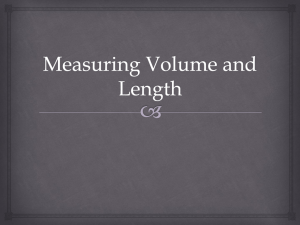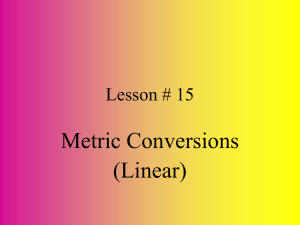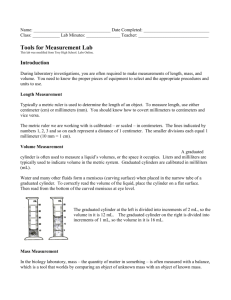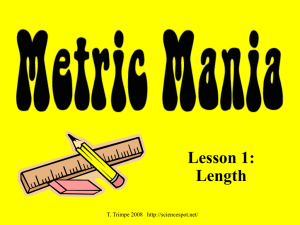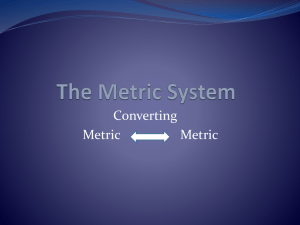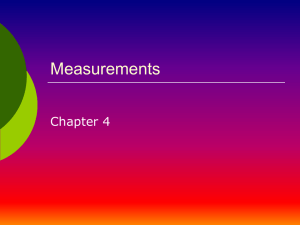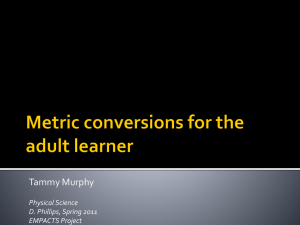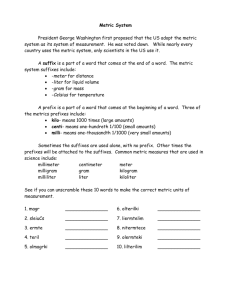File
advertisement
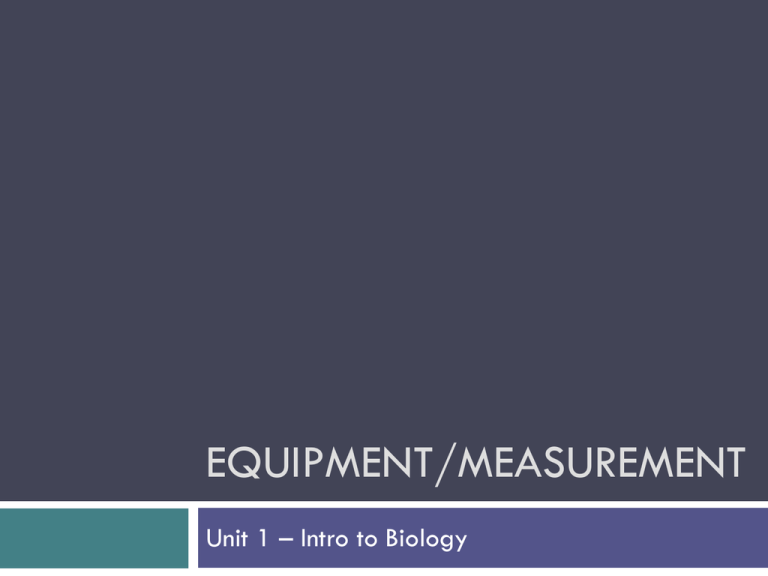
EQUIPMENT/MEASUREMENT Unit 1 – Intro to Biology Lab Equipment Review Unit 1 – Intro to Science Lab Equipment Review Graduated Cylinder Used to measure volume. Beaker Holds liquids Lab Equipment Review Flask glassware used in making, heating and storing solutions. Metric Ruler Used to measure length Lab Equipment Review Thermometer Used to measure temperature, can be alcohol or mercury. Petri Dish Covered dish, used to grow/culture bacteria. Lab Equipment Review Electronic Balance Electronic device used to find the mass of an object. Hot Plate Heats substances using electricity. Lab Equipment Review Filter Paper Filters out/separates solid substances from liquids. Forceps Used to hold or pick up small objects. Lab Equipment Review Dissecting Pins Used during the dissection process to keep specimen parts in place. Dissecting Tray Used to hold/contain specimen during dissection. Lab Equipment Review Goggles Protects your eyes. Apron A garment worn to protect your clothing. Lab Equipment Review Scissors used to cut materials. Microscope related material will be covered in a separate lecture. Measurement Unit 1 – Intro to Science The Metric System The basic unit of length in the metric system in the meter and is represented by a lowercase m. Metric Units 1 Kilometer (km) 1000 1 meters Meter 100 Centimeters (cm) 1 Centimeter 10 Millimeters (mm) Measuring Length How many millimeters are in 1 centimeter? 1 centimeter = 10 millimeters What is the length of the line in centimeters? _______cm What is the length of the line in millimeters? _______mm HINT: Round to the nearest tenth. Ruler: http://www.k12math.com/math-concepts/measurement/ruler-cm.jpg The Metric System Mass refers to the amount of matter in an object. The base unit of mass in the metric system in the gram and is represented by g . Metric Units 1 1 Kilogram (kg) 1000 Grams (g) Gram (g) 1000 (mg) Milligrams The Metric System Volume is the amount of space an object takes up. The base unit of volume in the metric system in the L and is represented by L or l . Metric units 1 liter (L) 1000 milliliters (mL) Measuring We will be using a graduated cylinder to find the volume of liquids and other objects. meniscus Read the measurement based on the bottom of the meniscus or curve. When using a real cylinder, make sure you are eye-level with the level of the water. What is the volume of water in the cylinder? _____mL What is the volume of water in each cylinder? Pay attention to the scales for each cylinder. Images created at http://www.standards.dfes.gov.uk/primaryframework/downloads/SWF/measuring_cylinder.swf Measuring Volume Measuring Volume 9 cm We can measure the volume of regular object using the formula length x width x height. _____ X _____ X _____ = _____ 8 cm We can measure the volume of irregular object using water displacement . Amount of H2O with object = ______ About of H2O without object = ______ Difference = Volume = ______ esources.edb.gov.hk/~s1sci/R_S1Science/sp/en/sy llabus/unit14/new/testingmain1.htm 10 cm Conversion Practice Try these conversions using the ladder method. 1000 mg = _______ g 1 L = _______ mL 160 cm = _______ mm 14 km = _______ m 109 g = _______ kg 250 m = _______ km Metric Conversion Write the correct abbreviation for each metric unit. 1) Kilogram _____ 4) Milliliter _____ 7) Kilometer _____ 2) Meter _____ 5) Millimeter _____ 8) Centimeter _____ 3) Gram _____ 6) Liter _____ 9) Milligram _____ Try these conversions, using the ladder method. 10) 2000 mg = _______ g 15) 5 L = _______ mL 20) 16 cm = _______ mm 11) 104 km = _______ m 16) 198 g = _______ kg 21) 2500 m = _______ km 12) 480 cm = _____ m 17) 75 mL = _____ L 22) 65 g = _____ mg 13) 5.6 kg = _____ g 18) 50 cm = _____ m 23) 6.3 cm = _____ mm 14) 8 mm = _____ cm 19) 5.6 m = _____ cm 24) 120 mg = _____ g
